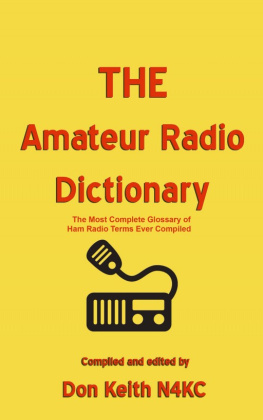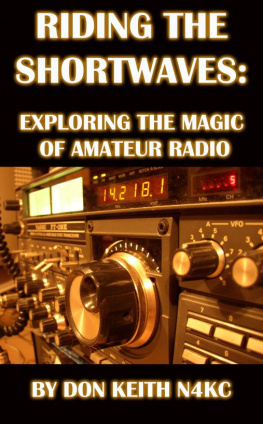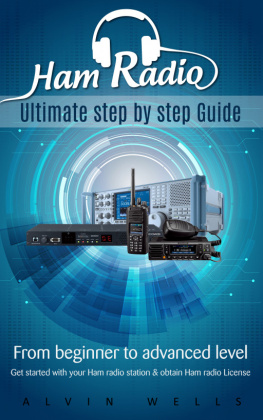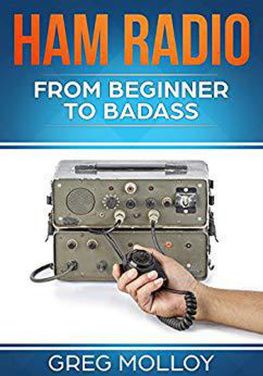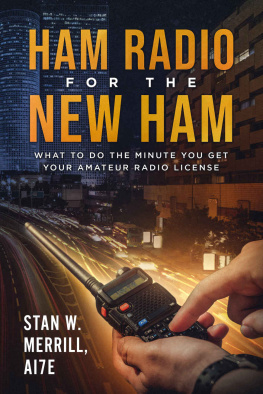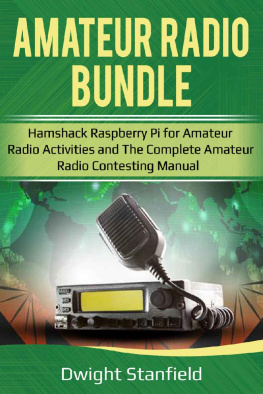THE
Amateur RadioDictionary
The Most Complete Glossaryof Ham Radio Terms Ever Compiled
Edited by Don KeithN4KC
EP
Erin Press
Indian Springs Village,Alabama
2015 by Don Keith
All rights reserved. Noportion of this work may be reproduced without express writtenpermission of the author except for brief excerpts in reviews.Please contact the author by e-mail at for permission to reproduce any portion of thisbook. This includes permission to reprint excerpts in suchpublications as Amateur Radio club newsletters or HamRadio-oriented periodicals. These are encouraged andwelcomed.
This work appeared in aslightly different form as a part of the book GET ON THEAIRNOW!
Contact the publisher atthe following address:
Erin Press
40 Red StickRoad
Indian Springs Village, AL35124
Also by DonKeith
The ForeverSeason
Wizard of theWind
The Rolling ThunderStockcar Racing Series (with KentWright)
Final Bearing (with George Wallace)
Gallant Lady (with Ken Henry)
In the Course ofDuty
The Bear: the LegendaryLife of Coach Paul Bear Bryant
Final Patrol
The Ice Diaries (with Captain William R. Anderson)
War beneath theWaves
We Be Big (with Rick Burgess and Bill Bubba BusseyKJ4JJ)
Undersea Warrior
Firing Point (with George Wallace)
Riding theShortwaves:
Exploring the Magic ofAmateur Radio
The Spin
The Road to KingdomCome
The Ship that WouldntDie
Get on theAirNOW!
Writing with EdieHand:
The Last ChristmasRide
The SoldiersRide
The Christmas Ride: theMiracle of the Lights
www.donkeith.com www.n4kc.com
CONTENTS
INTRODUCTION
Any pursuit that mankindmight adopt quickly develops its own language, its proprietaryjargon, its own semi-secret dialect fully understood only by itsmost avid and serious practitioners. Some even consider it to be apart of the hazing process, the price for becoming a member of thetribe.
Consider golf. Would anewcomer to the game know what a mulligan was? Or a divot? Would anovice fisherman be able to define a jig, a spinner bait, or a30-pound-test line?
Amateur Radio is certainlyno exception, though I prefer to think it is not really a hazingprocess. The hobby has now been around for more than a hundredyears and has created through all that time its own dialect to besure. Add to that the whole technical side and the governmentalregulation aspect and it becomes even more of a challenge. All ofthis mumbo jumbo is not designed to flummox the newcomer at all. Itis not some top-secret handshake to prevent others from entering atop-secret fraternity.
It is simply the wayterminology develops and morphs over the years. Furthermore, with apastime as dynamic and ever-changing as Ham Radio, it is inevitablethat its verbiage changes and increases tremendously. Changes andincreases so that even those who are active in the hobby may stillneed to be able to look up new terms as they come into common use.Or slip in while the Ham was busy in some other realm of thismulti-faceted hobby.
Example: ask even thelongest-tenured Amateur Radio operator to define JT-65. Or totell us what an IOTA is. Or to give a quick overview of DSP oroutgoing QSL bureau.
That, then, is the reasonfor this dictionary.
When I returned to thehobby after quite a few years of inactivity, I was amazed at howmuch everything had remained the same. But I was also amazed at howmuch it had changed. New technology, new operating events, newradiosport awards, new capabilities in our radios all made mewonder if I would ever catch up.
Many times during a QSO(see QSO in this dictionary) I wished for a quick-lookup thatwould tell me basically what it was that the guy on the air wastalking about when he asked me a question or made a casual comment.Unfortunately, I often had to admit my ignorance and ask forclarification. Or hastily refer to Google, which inevitably sent meoff into the weeds. Usually the fellow on the other end of theconversation was happy to explain it, giving me a chance tolearn.
Still, I wished for somekind of Amateur Radio dictionary that would at least give me abasic idea of what the term meant and lead me to ask the rightquestions when someone dropped an unfamiliar word on me. As usual,I searched online for a glossary. Quite a few exist. Most are basicand woefully incomplete. Others have not been updated since thetransistor. Some are totally technical and the definitions are notwhat I would expect to be helpful to someone new to all this Hamstuff.
I can only imagine howfrustrating it must be for the true newcomer to our wonderfulhobby. Or for others like me who might be returning to the hobbyafter a hiatus. Or for that guy in a chat on 6-meter SSB who isasked what he thinks of a hex beam or if he is inSMIRK.
What this dictionaryis
What I have attempted tocreate here is a simple but more complete dictionary than has everbeen attempted beforeto my knowledge. It contains the mostcommonly encountered terms and jargon any of us might run across inHam Radio.
I see the book assomething that can be kept near the operating position in onesradio shack for quick access. Or have it downloaded on an e-bookreader or tablet or computer for easy accessibility and searchability.
Language evolves. Even thebrand-name English dictionaries are revised regularly to add wordsand terms that emerge naturally, or to cull those that are nolonger commonly in use. Therefore I also see this work to be acontinuing thing. That is where you can help.
If you would like tosuggest a new word or term to add, or want to question mydefinition of a word, please email me at: . I will behappy to consider it for inclusion in this tome the next time it isupdated.
What this dictionary isnot
I will include a limitednumber of electronic or technological terms, those that the typicaloperator is most likely to encounter on the air or in groupdiscussions with other Hams. Others are simply beyond the scope ofthis work and their inclusion might juts overwhelm the user.Besides, there are many other publications and web sites that do afine job of that sort of thing, too.
First, I highly recommendthe purchase of the American Radio Relay Leagues (seeARRL) The ARRLs Handbook for RadioCommunications . The index can lead you toeasily understood descriptions and information about just about anytechnical term you will encounter in the hobby.
To purchase a new copy, orto find out more about Amateur Radio, visit the Leagues Web siteat: www.arrl.org . You can usuallyfind older copies of the handbook for sale at hamfests (seehamfest), in a boneyard (see boneyard) or in a flea market (seefleamarket). They will only lack the very latest terms. Volts andohms are still the same as they were a hundred yearsago.
There are also manyon-line sources for looking up electronics terms. They include, inno particular order:
http://www.maximintegrated.com/en/glossary/definitions.mvp/terms/all
http://www.csgnetwork.com/glossary.html
http://www.wilsonselectronics.net/dictionary.htm
http://www.hobbyprojects.com/dictionary/a.html
http://www.extron.com/technology/glossary.aspx
Again, this dictionary isdesigned as a quick lookup resource for newcomers (and old-timers,too!) to use when encountering a new or unfamiliar term whileoperating, listening, or reading. Heres an idea,though.
You may want to simplyread through it at your leisure. Some term you thought youunderstood may mean something different altogether! Or you mayhappen upon some totally new ones. Of course, it may also spur youto suggest some that you feel need to be included, and I hope youwill email those to me post haste.
Now, if you are new to HamRadio, welcome to the worlds greatest hobby. Enjoy!Learn!
If you have been licensedsince the 20s, I hope you are still enjoying the hobby as much asyou did the day you first fired up that spark gap transmitter (seespark gap) and worked your first DX (see DX). But even you mayfind some new terms here that you are not sure about.
Next page
